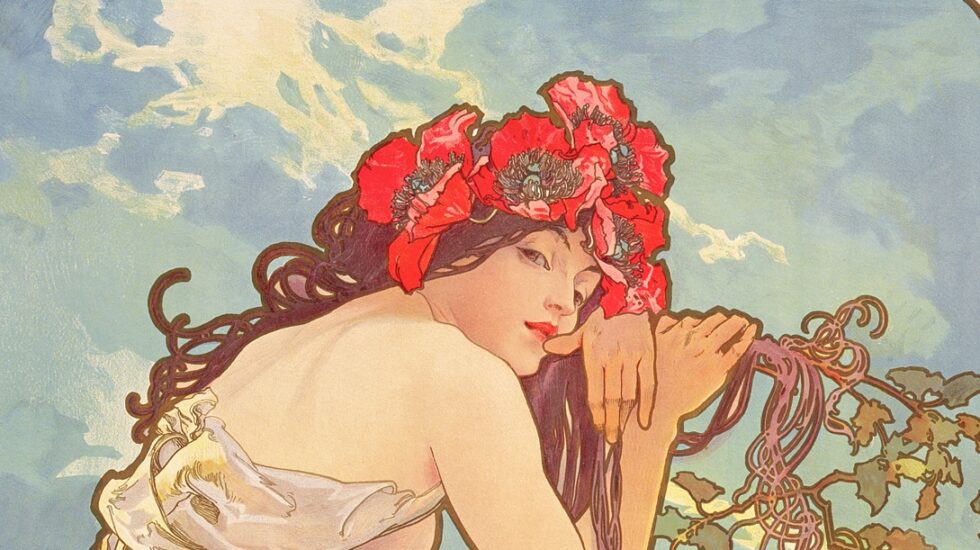The most famous name of poster art: Who is Alphonse Mucha?
He has had a great impact on the art world in the fields of graphic design, poster art, illustration, and decorative art. The artist's works are known for graceful figures, natural motifs, and curved lines. Mucha's art establishes a deep connection with the aesthetics and cultural fabric of the period.

Famous Czech artist Alphonse Mucha, who lived in the 19th and early 20th centuries, is one of the leading representatives of the Art Nouveau movement. The artist's life reflects a style of art that meets aesthetics and elegance. Mucha's works are adorned with graceful figures, the beauties of nature, and curved lines, and are leading examples of poster art. In addition, little-known and interesting details about Mucha's life are among the highlights of the artist.
Alphonse Mucha is an artist of Czech origin and one of the most well-known representatives of the Art Nouveau movement. He has had a great impact on the art world in the fields of graphic design, poster art, illustration, and decorative art. The artist's works are known for graceful figures, natural motifs, and curved lines. Mucha's art establishes a deep connection with the aesthetics and cultural fabric of the period.
Alphonse Mucha was born on July 24, 1860, in the Moravian region of the Austro-Hungarian Empire. The artist attracted attention with his interest in art at a young age. After studying in Prague, he moved to Vienna and studied decorative painting and graphic design.
Alfons Maria Mucha (24 July 1860 – 14 July 1939), known internationally as Alphonse Mucha, was a Czech painter, illustrator, and graphic artist. Living in Paris during the Art Nouveau period, he was widely known for his distinctly stylized and decorative theatrical posters, particularly those of Sarah Bernhardt. He produced illustrations, advertisements, decorative panels, as well as designs, which became among the best-known images of the period.
When he moved to Paris in later years, he met many important artists and designers, especially under the influence of the Art Nouveau movement. He gained fame during this period and gave a great impetus to his artistic career, especially by collaborating with the well-known French actress Sarah Bernhardt.
Alphonse Mucha's art is one of the most impressive examples of the Art Nouveau style. This style is based on an aesthetic approach that combines organic nature motifs with elegant and curved lines. Mucha is known for his pastel color palette and detailed designs. He created his works using especially female figures, flowers, and ornaments.
The artist has also achieved great success in the field of poster design. The “Gismonda” poster he designed for Sarah Bernhardt is one of his most iconic works. Mucha's art reflects the cultural richness and understanding of the beauty of the period.
Alphonse Mucha died in Prague on July 14, 1939. Following his death, the legacy and impact of his art grew even further around the world. Mucha continues to be remembered as one of the leading figures of Art Nouveau, and the enduring legacy of his art lives on.
In addition to art, Mucha also worked in photography and design.
Due to his family's financial difficulties, he started working at a young age and lived in poverty for a while in Vienna.
During World War I, he supported the independence of Czechoslovakia.
While Mucha's art represents the peak of Art Nouveau, he turned towards more religious and philosophical themes in the later stages of his life.
1860: Alphonse Mucha was born on July 14 in Ivan Ice, Moravia, a province of the Austro-Hungarian Empire. Mucha, the son of a bailiff, learned the principles of nationalism from his family. He started painting at a young age.
1871: He received secondary education at St. Peter's Cathedral in Brno, where he served as a chorister. It was here that he was first impressed by the richness of Baroque art. During the four years he spent in Brno, he formed a friendship with Leos Janácek, who would become the most important Czech composer of his generation.
1877: Failed to enter the Academy of Arts in Prague.
1879: He started working in a company that made designs for theater in Vienna.
1881: Mucha was forced to quit his job as a designer after a fire caused extensive damage to the Ringtheatre, the company's biggest customer. He settled in the small city of Mikulov and started working as a portrait painter. Here he met his first patron, Count Khuen, and upon his invitation, he decorated Emmahof Castle with murals.
1884: Studied art in Munich while continuing to work in Tyrol for Count Egon, brother of Count Khuen.
1888: He settled in Paris, which was experiencing the excitement of the upcoming Exposition Universelle.
He entered the Académie Julien, where he met the Nabis (Sérusier, Vuillard, Bonnard, and Denis). They shared the same workshop with Gauguin, whom he also met here, in 1893. Puvis also joined the Symbolist movement led by Chavannes, Redon, Moreau, and Huysmans.
1889: He drew his first illustrations.
1894: He designed Gismonda, his first poster for actress Sarah Bernhardt, and signed a six-year contract with Bernhardt. This turning point in his life enabled Mucha to turn his career towards posters.
1900: Designed different pavilions for the Exposition Universelle, including that of Bosnia and Herzegovina. During the same period, he also worked for the jeweler Fouquet. In this way, he later realized different projects for Fouquet's boutique.
1904: He settled in America.
1913: He returned to his hometown permanently. He began painting patriotic murals and preparing his collection, which he called the Slavic Epic.
1928: He gifted twenty paintings of the Slav Epic to the Czech people and the city of Prague.
1936: An exhibition dedicated to Mucha and his compatriot Franti ek Kupka opened at the Real Games Gallery.
1939: Alphonse Mucha died of pneumonia on July 14.
----------------
https://tr.pinterest.com/zofiawb/alfons-maria-mucha-alphonse-mucha-some-works-inspi/
